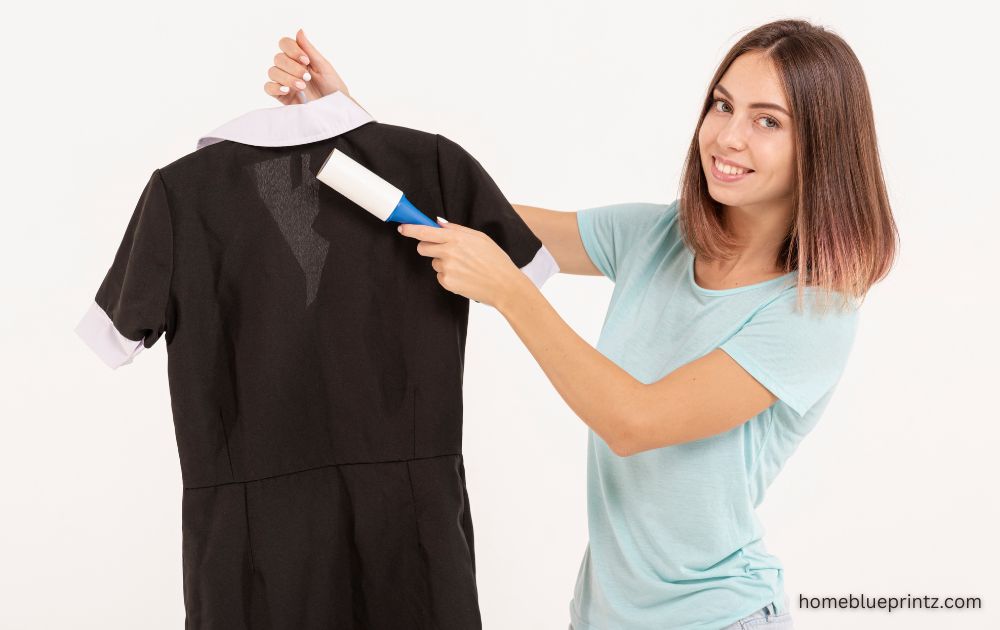Clothes Lint: The Hidden Foe of Your Wardrobe and How to Defeat It
We’ve all been there pulling out a favorite sweater only to find it covered in annoying little fuzz balls. That’s lint, the tiny fibers that shed from clothes during wear or washing. Lint isn’t just unsightly; it can make your outfits look old and neglected, even if they’re new. But what exactly causes it, and how can you keep it under control?
Why Does Lint Form on Clothes?
Lint forms on clothes when tiny fibers break loose from fabrics due to friction during washing, drying, or everyday wear. As garments rub against each other, these loose fibers detach and cling to other materials, especially those that generate static. Fabrics like cotton, wool, and fleece shed more lint because of their soft, short fibers, while synthetics tend to attract it. This constant exchange of fibers is what causes that fuzzy layer we call lint.
The Frustration of Lint on Clothes
The frustration of lint on clothes is something everyone can relate to. Nothing ruins the look of a freshly washed outfit faster than those tiny fuzz balls clinging stubbornly to the fabric. They make clean clothes appear old, worn, and neglected, especially on darker materials where lint stands out the most. It’s not just about appearance either constant lint buildup can also make you feel less confident and polished.
How Lint Affects the Lifespan of Your Clothes
Lint doesn’t just affect appearance it also shortens the lifespan of your clothes. When fibers constantly shed, the fabric becomes thinner and weaker over time. This gradual wear can cause colors to fade, materials to lose shape, and garments to look aged before their time. Regular lint buildup is often a sign that your clothes are slowly wearing out from friction and poor washing practices.
Top Causes of Excessive Lint Buildup
Excessive lint buildup usually happens when clothes shed too many fibers during washing or drying. Poor laundry habits and fabric choices often make the problem worse. Here are the main causes:
- Overloading the washer or dryer increases friction and fiber shedding.
- Mixing different fabric types (like cotton and polyester) causes lint transfer.
- Static electricity attracts and holds lint on synthetic materials.
Preventing Lint Before It Starts
Preventing lint before it starts is all about taking a few smart laundry precautions. By sorting clothes properly, using gentle detergents, and managing static, you can significantly cut down on lint buildup. Here’s how:
- Sort clothes: Separate lint-producing fabrics (like towels) from lint-attracting ones (like synthetics).
- Use mild detergent: Choose one that protects fibers and minimizes shedding.
- Add fabric softener: It reduces static, helping prevent lint from clinging to clothes.
How to Remove Lint from Clothes
Removing lint from clothes doesn’t have to be a struggle. The easiest method is using a lint roller just glide it over your garments to pick up fuzz and loose fibers instantly. If you’re looking for a quick refresh, toss your clothes in the dryer with a dryer sheet to reduce static and lift away lint. For more stubborn buildup, a fabric brush or electric lint shaver works wonders, gently removing fuzz without harming the fabric. With a little care, your clothes can look fresh and lint-free again.
Homemade Lint Removal Hacks
Homemade lint removal hacks are simple, affordable, and surprisingly effective. You don’t need fancy tools—just a few household items can do the trick. Try these quick solutions:
- Tape Trick: Wrap sticky tape around your hand and pat away the lint.
- Vinegar Rinse: Add half a cup of white vinegar during the rinse cycle to loosen fibers.
- Pumice Stone: Gently rub over fabrics like wool to lift lint and fuzz.
Best Lint Remover Tools in 2025
In 2025, lint removal tools have become smarter, more efficient, and eco-friendly. From compact electric shavers to reusable brushes, there’s a perfect option for every fabric type. Here are some top picks to keep your clothes spotless:
- Conair Fabric Defuzzer: Powerful and gentle on all fabrics.
- Gleener Ultimate Fuzz Remover: Dual-sided tool for lint and pills.
- Beautural Fabric Shaver: Rechargeable and ideal for travel use.
Washing Machine and Dryer Maintenance Tips
Keeping your washing machine and dryer clean is key to preventing lint buildup and keeping clothes looking fresh. Regular maintenance not only improves performance but also extends the lifespan of your appliances.
- Clean the lint trap after every load: This prevents lint from redepositing on clean clothes and reduces fire risk.
- Check and clean the washer filter monthly: A clogged filter can cause lint and debris to stick to fabrics.
- Wipe drum and seals regularly: Removing residue and detergent buildup helps your machine work more efficiently.
Natural Ways to Reduce Lint
Reducing lint naturally is easier than you might think. Start by washing clothes inside out to minimize fiber shedding and using cold water to preserve fabric integrity. Adding white vinegar to the rinse cycle can help loosen lint and soften clothes without harsh chemicals. You can also use wool dryer balls instead of dryer sheets to collect lint and speed up drying time. Regularly cleaning the lint trap and dryer vent ensures better airflow and reduces buildup naturally.
Caring for Lint-Prone Fabrics
Caring for lint-prone fabrics requires gentle handling to keep them looking clean and smooth. Always wash these fabrics separately from items that produce lint, like towels or fleece. Use a mild detergent and cold water to prevent damage and reduce lint buildup. Turning clothes inside out before washing can also help protect their surface. Regularly using a lint roller or brush keeps the fabric neat and fresh-looking.
Eco-Friendly Alternatives to Lint Removal Products
Eco-friendly alternatives to lint removal products help reduce waste while keeping clothes clean. You can use a reusable lint brush or a washable lint roller instead of disposable ones. A damp cloth or rubber gloves can also pick up lint effectively from fabric surfaces. Adding vinegar to the wash cycle helps loosen lint naturally. These sustainable methods are gentle on clothes and better for the environment.
How to Store Clothes to Avoid Lint
To avoid lint on clothes, store them in a clean, dry place away from dust and fuzzy fabrics. Always fold or hang clothes after ensuring they are fully dry to prevent lint buildup. Use garment bags or fabric covers to protect delicate items. Keep lint-producing items like wool and towels separate from smooth fabrics. Regularly cleaning your closet and storage areas also helps keep lint under control.
Conclusion:
Lint might seem small, but it can make a big difference in how your clothes look and last. By understanding what causes lint and how to control it, you can keep your wardrobe fresh, polished, and lasting longer. With the right habits, even the fluffiest sweater can stay smooth and clean.
FAQs About Clothes Lint
- How do I permanently remove lint from clothes?
Use a lint shaver and follow proper laundry care sort clothes, clean filters, and avoid over-drying. - Why do my clothes get more lint after washing?
Mixing different fabrics and skipping filter cleaning often causes lint buildup. - Can vinegar help remove lint?
Yes! Vinegar helps loosen fibers and reduce static cling, preventing lint from sticking. - How often should I clean the lint trap?
After every dryer cycle. It keeps clothes clean and your dryer running efficiently. - Are lint balls the same as pilling?
Not exactly. Lint comes from external fibers, while pilling occurs when fabric fibers tangle on the surface of the garment.
Share this content:














Post Comment